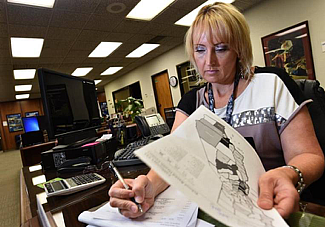Center for Health Journalism Support for Reporting on Education
The Center for Health Journalism defines health broadly to include conditions that lead to good health and well-being. Among the most important of them is education -- which the CDC defines as one of the strongest predictors of health, quality of life and life expectancy. Here are selected examples of reporting on health and education we've supported through training, grants and extensive mentoring of Center for Health Journalism Fellows.
As the nation's leading health journalism training center on community health and child well-being and welfare issues, the Center for Health Journalism helps journalists understand how experiences in their homes, communities and schools affect a person’s health and wellbeing over the life span. What happens in schools can prevent children from reaching their full potential.
Founded in 2004, the Center offers training and grants to journalists from around the country, exposing them to the latest scientific research, promising solutions and new ways of telling stories. We form partnerships with news outlets that yield compelling projects that put education and well-being on the public’s -- and policymakers’ -- radar screens.
Among the reporting projects on education issues that we have nurtured in recent years:
Failure Factories, Tampa Bay Times: 2015 National Fellow Michael Laforgia and colleagues documented actions by the Pinellas County School Board that led to the re-segregation of five previously integrated elementary schools and declines in test scores that made them some of the worst schools in Florida. Their project won a 2015 Pulitzer Prize and numerous other national investigative reporting awards. More importantly, it led to a federal civil rights investigation, the hiring of a school district "turnaround leader," new state money for improvements at the failing schools and a bevy of reforms in practices and policies. Within a year and a half, three of the five schools improved their schoolwide grades on the Florida Standards Assessments, with one jumping to a C from an F and two earning D's instead of F.
Toxic City, Sick Schools, Philadelphia Inquirer and Daily News: Over a three-year investigation, 2016 National Fellows Barbara Laker and Wendy Ruderman and several colleagues documented the exposure of Philadelphia school children to lead dust, mold spores and asbestos fibers in classrooms. They enlisted teachers and aides at 19 schools to sample surfaces in classrooms, as well as water coming out of drinking fountains, with alarming results. Dangerously high levels of cancer-causing asbestos fibers were found on surfaces in classrooms, gymnasiums, auditoriums, and busy hallways — residue from crumbling pipe insulation, damaged floor tiles, and deteriorating ceilings. Tests revealed lead dust, at hazardous levels, on windowsills, floors, and shelves in classrooms, including one for children with autism. Their project, which also looked at lead hazards in neighborhoods and homes, won many national awards and was a finalist for a Pulitzer Prize, resulted in four new protective laws; 770 landlords fined; $15.7 million in emergency school repair funds; more than 700 visits by health inspectors at addresses in neighborhoods with high rates of childhood lead poisoning; $900,000 in additional city money to protect kids from lead paint in their homes; nearly 10 acres of lead-contaminated land slated for cleanup in the city’s “river ward” neighborhoods; 3,400 children learning in eight newly repaired “lead safe” schools, with 38 more to be cleaned of lead paint in coming months. In addition, Pennsylvania Gov. Tom Wolf directed $15.7 million for emergency cleanup to repair lead paint and other hazards in more than 40 schools, a move to safeguard 29,000 children The Inquirer also created “School Checkup," an easy-to-use web lookup tool that pulls together internal district reports on incidents of damage to asbestos, mold growth, rodent droppings, and peeling lead paint at nearly 200 schools.
Lost Days, EdSource: 2018 Data Fellow David Washburn looked into absenteeism rates in California schools, and was surprised at what he found. The biggest problems weren't at urban schools, a focus of most media attention, but at rural schools. Among the 98 districts in California with chronic absenteeism rates above 20 percent, which the California Department of Education classifies as “very high,” 84 were in rural areas. And the 10 districts statewide with the highest rates, ranging from 43 percent to 79 percent, were all rural. Chronic absenteeism is a significant contributor to poor academic performance, high dropout rates and low levels of college readiness, according to a large body of research. Chronically absent students are also more likely to engage in high-risk student behaviors like drug and alcohol abuse and criminal activity. And the schools suffer as well from student absences, since their funding is tied to attendance. Washburn found that many of the absences were linked to poverty. Many students were responsible for the care of ailing relatives, or their families lacked cars to transport them to school if they missed the bus. “We have to understand how kids are being pulled away from school due to issues at home, and also how we are pushing them out,” Dena Kapsalis, the director of student services for the Paradise Unified School District, told him. [Washburn's reporting took place before the population in the district was decimated by the 2019 Camp Fire.] Washburn's reporting also documented the role that an aggressive suspension policy played in Butte County’s Oroville City Elementary School District, which prompted the California Bureau of Children's Justice to open an investigation.
Using Schools to Bring a Dying Rustbelt City Back to Life, Washington Monthly, HuffPost, Hechinger Report: 2017 National Fellow Emmanuel Felton journeyed to East St. Louis, Illinois, to report on efforts to transform the worst-performing school district in the nation. Once an industrial powerhouse across the Mississippi River from prosperous St. Louis, Missouri, East St. Louis had since lost most of its jobs because of disinvestment and white flight and became known for having one of the nation’s highest per-capita murder rates as well as some of the highest rates of childhood asthma and lead poisoning. Felton reported that East St. Louis residents were working together to connect all the various services available to families, from housing to counseling to job training, and provide access to them through the school district. The concept draws from a reform strategy called “collective impact” that many other struggling American cities are trying in different forms, he reported. And it seems to be paying off in East St. Louis, with student performance increasing and the graduation rate up.
Reading, Writing Evicted, The Oregonian: 2017 National Fellow Bethany Barnes, an education reporter, wondered how Portland's tight housing market was affecting its most vulnerable residents -- children in low-income families. Her six-month investigation found that the situation was dire. In Oregon’s largest school district, her data analysis found that more than 1,700 students in kindergarten through grade eight attended at least three schools in a five-year periods, and, in too many cases, several in a single year. In some schools in low-income, largely minority neighborhoods, one of every five students either showed up after the previous school year started or left before it was done. When a student switches to a new school district, teachers and other adults who care about his well-being lose access to records showing his grades, his attendance -- even whether he is enrolled in school at all. Both the students who move suffer as well as those left behind. Students who switch schools typically fall months behind their peers and are at a higher risk to drop out, research has found. The harm is most evident for low-income students who change schools and for students who change schools more than once over several years, studies show. A high rate of students entering or leaving a school mid-year not only sets back students who move but also their classmates who experience the churn, Barnes reported.
What It's Like to Go to School When Dozens Have Been Killed Nearby, Los Angeles Times: 2018 California Fellow Sonali Kohli (and colleague Iris Lee) captured the terror and anxiety that many Los Angeles students experience when walking to school through neighborhoods wracked by community violence. Their data analysis found 59 high schools in the district with 59 or more homicides within a mile of the school over the previous five years. One school had 105. Last year alone, 20 people were killed within a mile of that school— about one every 2½ weeks. Sometimes they are current or former students. When a friend dies, “they come in welled up with emotion, they’re crying and there’s no way they can concentrate on the lesson at hand, so whatever’s on the board as far as the lesson plan, that means nothing,” said Jason Powell, an English and music teacher at Mervyn N. Dymally High School, the school most affected.
Learning While Black, KALW Public Radio: 2018 National Fellow Lee Romney set out to explore the systemic inequities that have hampered African American students in San Francisco. She found that African American students are much more likely than any other student group to be placed in special education and post the lowest test scores and graduation rates and have the highest rates of suspension and chronic absenteeism. Rather than just chronicle the system's failings, she also showcased the resilience and power of black youth and their families and the efforts of educators and community advocates to help them thrive. A community engagement event we supported brought administrators and families together and put issues long swept under the rug on the table for ongoing discussions.


